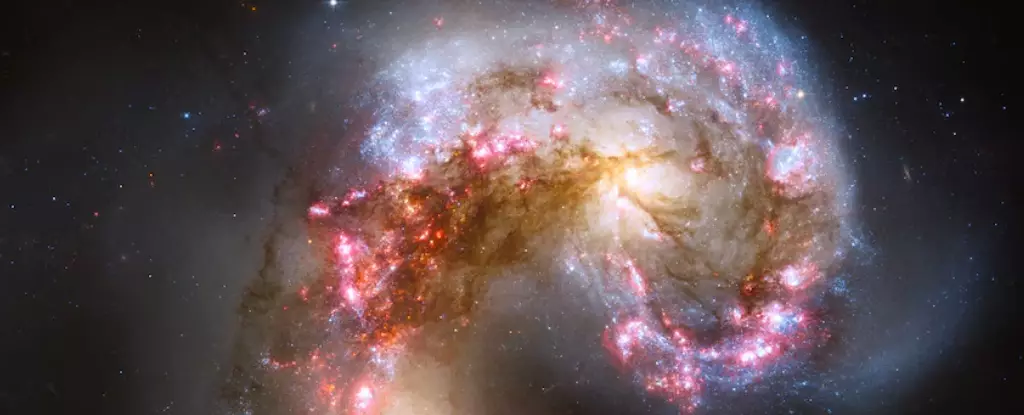The vastness of the Universe continually invites both curiosity and humility, reminding us of the profound mysteries that still elude our understanding. Among these enigmas, the formation of massive elliptical galaxies has remained a captivating puzzle for astrophysicists. Recent findings by a collaborative team of scientists have shed new light on this topic, providing compelling observational evidence that enriches the narrative of cosmic evolution. Their work, recently published in the prestigious journal *Nature*, marks a significant transition in our comprehension of galaxy formation.
In the realm of contemporary astrophysics, galaxies are typically classified into two prominent categories: spirals and ellipticals. Spiral galaxies, such as our own Milky Way, are characterized by their flat, rotating discs, often teeming with gas and active star formation. Conversely, elliptical galaxies stand out due to their large, spherical structure, resembling elongated spheres rather than flat discs. Unlike their spiral counterparts, elliptical galaxies do not actively generate new stars; instead, they are predominantly composed of stars that formed over 10 billion years ago. This distinction raises an important question: how did these stellar giants come to be, and what mechanisms drove their formation?
The formation of elliptical galaxies has long posed challenges to existing cosmological models that attempt to narrate the Universe’s evolution from the Big Bang to the present day. A central mystery lies in the historical understanding of stellar formation during the epoch of elliptical galaxies’ inception, believed to be between 10 to 12 billion years ago. Historically, it was assumed that star formation occurred within large, flat, rotating discs, akin to contemporary spiral galaxies. So, what compelled these galaxies to transition from flat formations to their current three-dimensional elliptical shapes?
In a pivotal analysis, researchers utilized observations from the Atacama Large Millimeter/submillimeter Array (ALMA) to delve into the formation sites of giant elliptical galaxies. The groundbreaking discovery made was the identification of local elliptical galaxies arising from brief, intense bursts of star formation in the nascent Universe. This paradigm shift suggests that opposite to prior beliefs, these galaxies may not have emerged from rotating discs but were spherical from their inception.
The team meticulously examined dust distribution in over 100 distant galaxies formed during the period when the Universe was between 2.2 and 5.9 billion years old. Dust acts as a proxy for the presence of gas, an essential ingredient for star formation, illuminating regions where stars are actively born. The compact nature of the dust observed contradicted expectations for disc-shaped galaxies, hinting instead at a spherical formation model similar to the elliptical galaxies we observe today.
To further elucidate their observational findings, the research team employed sophisticated cosmological computer simulations to examine the underlying dynamics responsible for the compacting of gas and dust in these ephemeral star-forming epochs. Simulations indicated that gas streams from surrounding galaxies and galactic interactions or mergers played pivotal roles in funneling material towards the cores of these galaxies, resulting in rapid formation processes characteristic of elliptical galaxies in the early Universe.
These simulations offer a critical insight into the mechanisms that facilitate the swift formation of ellipticals, providing a coherent narrative that aligns observational data with theoretical models of galaxy evolution.
A noteworthy component of this research was the novel methodology employed for analyzing ALMA data, which diverges significantly from traditional optical observations. Through a technique known as interferometry, which synthesizes signals from multiple antennas to form a larger virtual telescope, researchers achieved exceptionally sharp images of distant galaxies. Despite the complexities involved in deciphering this data, the refinement of measurement techniques has significantly enhanced our understanding of dust distribution.
Moreover, the study underscores the importance of utilizing archival, open-access data from ALMA, reinforcing the idea that collaborative scientific endeavors and shared datasets are imperative for driving forward the frontiers of knowledge.
As we stand on the cusp of further exploration into the structures of early galaxies, future observations from the James Webb Space Telescope (JWST) and Euclid will continue to map the stellar distributions within these ancient cosmic entities. Upcoming instruments like the Extremely Large Telescope, with its remarkable 39-meter mirror, promise to deliver unparalleled insights into star-forming cores in distant galaxies. Enhanced observations from ALMA and the Very Large Telescope will also aid in deciphering the dynamic interplay of gas movements towards galaxy centers, ultimately revealing how these processes affect the formation of the celestial bodies we observe today.
This growing understanding of galaxy evolution not only fills a significant gap in our cosmic history but also ignites anticipation for ongoing discoveries that will shape our perception of the Universe’s vast and intricate architecture.


Leave a Reply